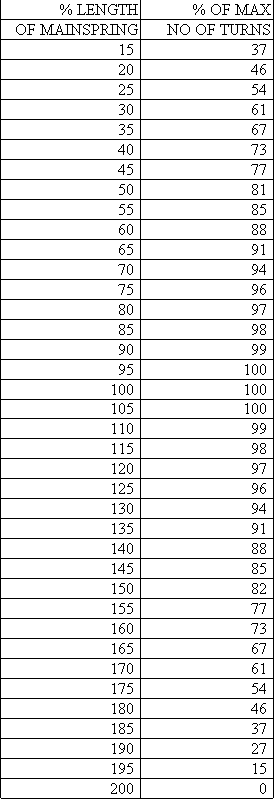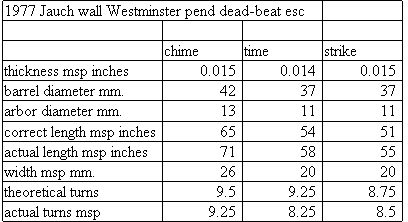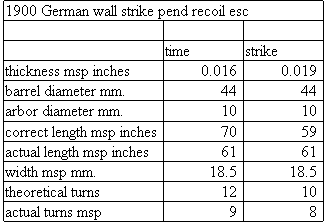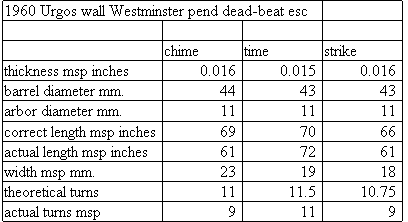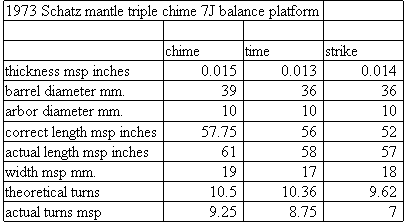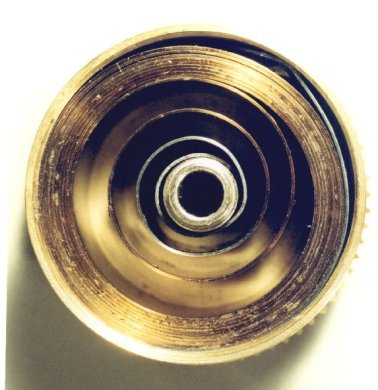Here is the spreadsheet you could use to calculate mainspring lengths. You should be able to
download it into your computer and save it. This is a ZIP file and contains an MS Works 4.0 and an Excel 4.0 file (Win95) and looks like the chart below. The
numbers in bold are where you enter your data.
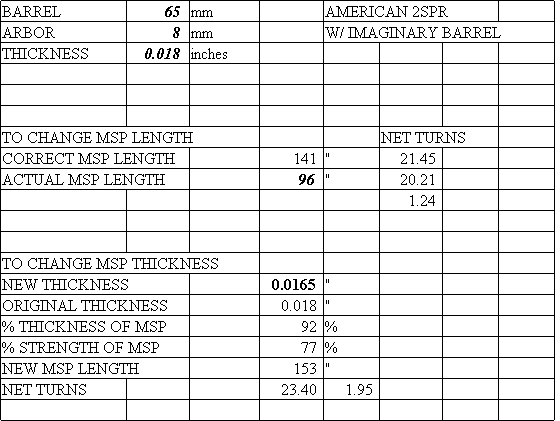 |
Mainsprings for American Clocks
I am interested in finding a way to measure the force exerted by mainsprings, but have been unable to find one accurate enough to yield useful results. I applaud Mr. Boxhorn's effort in the January 1997 issue of the Clockmaker's Newsletter.
While I agree that many of the mainsprings on the market intended for American clocks are excessively powerful, I urge caution in dramatically reducing the applied strength when replacing one. The 0.014" spring may work well when new, but in a few years it may have problems as it loses some strength. There are many reasons why caution should be exercised. I will only mention three:
1: American clocks, such as the Seth Thomas #89 movement, have pivots in the upper end of the train, (fourth wheel, escape wheel, warning wheel, governor, and pallets), that can be as much as 50% thicker (or of even greater diameter) than pivots in most foreign clocks. Exceptions include large, higher grade European grandfather clocks, French Morbier clocks, and oriental reproductions of American clock movements. Bigger pivots result in more friction because a greater circumference of pivots passes by for every turn the gear makes, and this higher level of friction is exacerbated when the lubricant gets older and thickens and has a dragging effect on the turning pivot. Further, the binding effect caused by a floating particle contaminating the bushing lubricant is much greater as the particle becomes jammed between the pivot and the bushing wall in the worn portion of the bushing as the pivot continues to turn.
2: The typical American clock escapement is a strip recoil escapement, which makes no pretense of being efficient. More power needs to be applied to the pallets to make up for this inefficiency: I would suggest at least 50% more than for a deadbeat escapement. I came to this conclusion by comparing a typical early 19th C. British grandfather clock with a recoil escapement and a typical early 20th C. German grandfather clock with a deadbeat escapement and cable-driven weights. The British clock needs a much heavier weight for the time-train. The efficiency of the escapement depends on the angles of the pallets' impulse faces relative to the respective
tangents off the circle made by the tips of the escape wheel teeth. These angles vary widely, and therefore so do the efficiencies of the escapements. Some excess power is necessary to overcome this.
3: Different pendulums have different power requirements. A short and light pendulum with a thinner suspension spring needs less power than a longer and heavier pendulum with a thick suspension spring. A heavier Seth Thomas 124 pendulum may stop when hung on an Ingraham high-beat clock that was intended to have a light pendulum. There is argument about how heavy a pendulum should be and what effect this has on accuracy. I expect this argument may never be resolved because these variables cannot be quantified. However, we can safely say that a heavier pendulum usually needs a thicker suspension spring to prevent wobble and more power from the escapement to keep it going.
I feel that point #2 above is the most critical, because so much power is lost in even the best-designed escapements.
Since there is so much unknown about the power requirement about a particular clock, manufacturers wisely choose to err in favor of some excess power to make up for variations in manufacture and for differences between movements. Repairmen should do the same.
Since there are some repairmen, however, who are intent upon using weaker mainsprings, the following information may help. Mr. Dan Henderson, a Senior Manufacturing Technology Engineer at 3M, shared with me a formula for springs. All other factors being equal, the strength of the spring is proportional to its width: in other words, if we double the width, we double the strength. Similarly, the strength is proportional to the cube (to the power of 3) of the thickness: if we double the thickness, the spring is eight times stronger (2x2x2=8).
 |
 |
where f is force (or strength), b is the base (or width of the mainspring), and h is the height (or thickness of the mainspring). This means that the 0.014 inch mainspring has 47% of the strength of the 0.018 spring. I would be very careful in replacing a mainspring with one that is less than half as strong as the former.
K in the above formula is a constant, or a number. It reflects other factors that affect the strength of the spring. These include the shape of the spring, the temper and composition of the metal, variations in thickness along the length of the spring, whether the spring is new or several years
old, to name a few. Since it is very unlikely that two springs will be of the same temper, etc, this formula does not provide a precise measure of strength: it can, however, provide a guideline for a clockmaker comparing two springs that appear to be similar, such as two new mainsprings from the same manufacturer, but of different thicknesses.
Timesavers is now selling a new mainspring for American clocks, part number 18790. It is 3/4" wide, 0.0165" thick, and 96" long. By the above formula, we can approximate it to have 77% of the strength of a similar 0.018" thick spring. If you believe that the mainspring in your American clock is too strong, I recommend that you try this mainspring. I have used it several times. I feel that a more moderate reduction in power would be more prudent.
Mainsprings in American Clocks
Clock Repair Main Page
Escapements in Motion
Links Page



